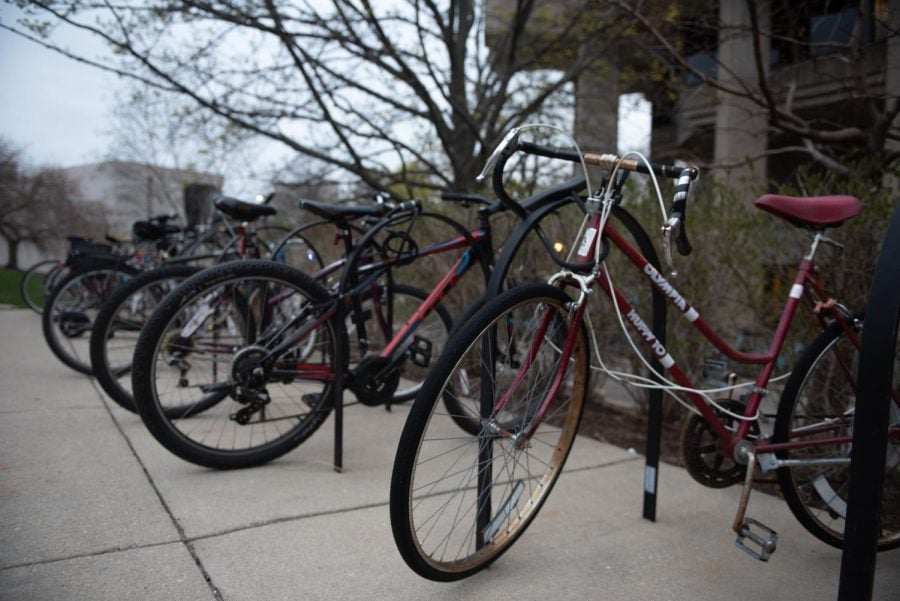Chicago-area biking groups push for bike trail upgrades, sustainable infrastructure
Seeger Gray/The Daily Northwestern
Local biking organizations are seeking to improve bike trails and infrastructure in Evanston, Chicago and surrounding areas.
April 27, 2022
John Fervoy, an avid cyclist and Evanston resident, used to occasionally bike from Evanston to downtown Chicago for work. But hazardous bike routes and poorly marked streets made his commute consistently a “hassle.”
“Dead ends and our manmade infrastructure — the channel and the railroad embankment that runs through town — block off easy transit for bikes, making (biking options) mostly the busier streets,” Fervoy said. “There’s a challenge getting around those.”
Fervoy is a member of the local biking and structural advocacy organization Evanston Transit Alliance. He said members of the alliance have designated Evanston as the place “where the trails end” because of their struggles navigating local bike routes.
ETA joins a handful of Chicago-area organizations working to reduce bike transit barriers. These groups advocate for the city to upgrade roads and infrastructure to support usable bike networks, which would allow cyclists to travel safely throughout Evanston, Chicago and beyond.
With rapidly changing public transit mask mandates and climate plans in Evanston and Chicago calling for infrastructure shifts, organizers said now is the perfect time for bike network upgrades.
“The whole point of this mission going forward is getting people to reduce the number of car trips and have them walking, biking, using public transit — really making sure the number of (car) dependents goes down in the city,” said Alex Perez, the advocacy manager of Active Transportation Alliance.
Active Transportation Alliance, an organization dedicated to promoting this type of infrastructure in the Chicago area, has worked closely with transit activism groups all over the region, including ETA, to push local governments to fund better bike infrastructure.
According to Perez and Fervoy, ETA is currently pursuing a plan to extend the North Shore Channel Trail by 1.5 miles northeast from its current ending point off Green Bay Road. The proposed route would connect the trail to the Wilmette Harbor and the start of the Green Bay Trail.
The plan would create a bike trail that runs along the channel’s embankment, allowing cyclists to pass through the stretch of channel banks without passing through the Canal Shores Golf Course or nearby roads. Fervoy said Evanston and Wilmette city officials are considering the plan.
Fervoy said the North Shore Channel and the Metra line running through the city both cut biking routes in Evanston. This mirrors other city structures in Evanston, like redlining, that have disproportionately cut off low-income and marginalized communities from accessible transportation paths.
Connecting the Wilmette community along the Green Bay Trail and the Evanston community along the North Shore Channel Trail is also essential, he emphasized.
“Right now, the trails that we have are kind of separate recreational facilities for different communities,” Fervoy said. “If you’re able to connect them, then they become a transit corridor for everybody.”
Skokie Bike Network, a Skokie-based transit alliance, is also working on similar infrastructure projects. Charlie Saxe, a founding member of Skokie Bike Network, said the group’s biggest undertakings include rebuilding a portion of Crawford Avenue between Golf Road and Oakton Street, and adding bike lanes to Church Street.
Saxe, a bike commuter himself, said the group is committed to creating safer, more accessible bike routes along roads with heavy traffic.
“People who are experienced and confident cyclists can manage with that (traffic),” he said. “But if you have people with young kids, for example, or if you have people who are not as confident or a little more intimidated by the traffic, that becomes pretty much a barrier.”
Optimizing public infrastructure to encourage cycling also has major environmental benefits, organizers said. According to the Environmental Protection Agency, transportation made up 27% of U.S. greenhouse emissions in 2020. Greenhouse gas emissions from transportation primarily come from burning fossil fuel for cars, trucks, ships, trains and planes, said the report.
On Monday, Evanston City Council declared a climate emergency and pledged to move its Climate Action and Resilience Plan to the top of its agenda. The plan which was passed in 2018, includes a transportation and mobility focus area, which aims to reduce carbon emissions and facilitate greater use of public transit and biking trails.
However, Perez and Fervoy both said Evanston and Chicago have failed to prioritize eco-friendly transit as part of their respective climate action plans. As infrastructure upgrades continue, Perez said bringing sustainability to the forefront is crucial.
“What’s really important now is advocating for specific plans, like giving us a network of protected bike lanes, giving us a network of bus lanes in the timeframe of these climate benchmarks,” Perez said.
Email: [email protected]
Twitter: @lilylcarey
Related Stories:
— City council declares climate emergency in Evanston
— Ramos Bechara: Bikes are essential to a successful off-campus living experience
— CARP struggles to gain traction three years after its implementation


